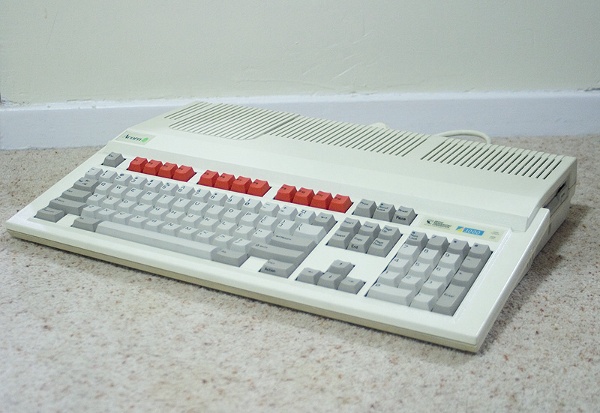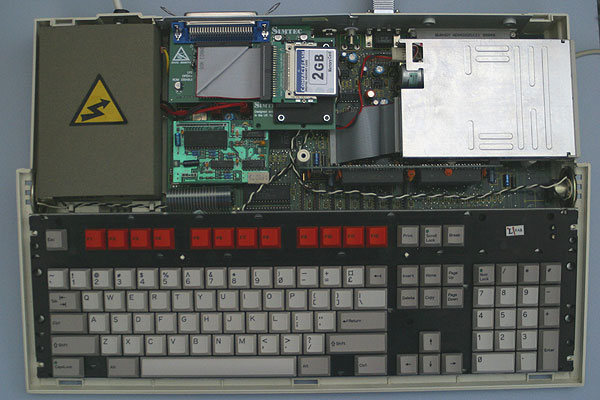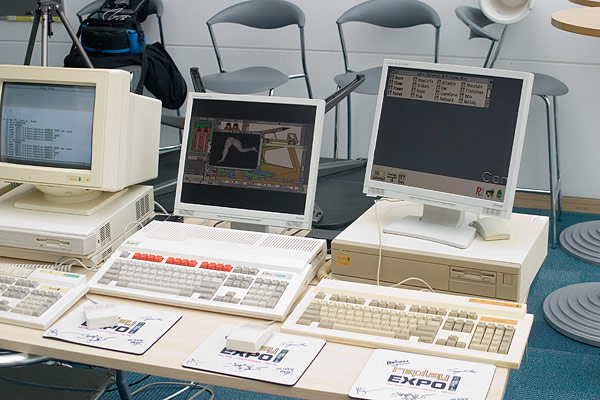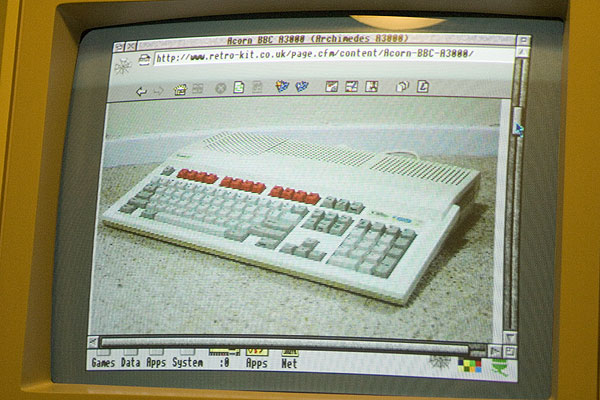Acorn BBC A3000
The Acorn BBC A3000 launched in May 1989 and was the last Acorn machine to be part of the BBC Computer Literacy Project and carry the label of "British Broadcasting Corporation Microcomputer System."

The BBC A3000 signalled a return to the integrated keyboard form factor for Acorn after producing the "three box" designs of the earlier Acorn Archimedes computers. The A3000 was intended to be the entry level "home user" version of the second generation Acorn Archimedes A400/1 series that was launched at the same time although in terms of specifications, the A3000 was most similar to the Acorn BBC Archimedes A300 series of computers as it provided a monochrome composite TV out socket and did not have on board support for a hard disc drive together with a lack of backplane capability (although 3rd parties developed external backplanes later).
The Acorn BBC A3000 although predating its replacements, the A3010 and A3020 by three years, is in fact the most expandable of the three "one box" RISC OS based machines and it can be expanded to a level that out performs its ARM250 based successors.
Early Acorn A3010 have similar expansion capabilities to the A3000 due to the presence of an ARM2 based mezzanine board being fitted for its processor but the later A3010 and all A3020 machines had the ARM250 CPU fitted which consists of an ARM2 processor and its support chips VIDC1a, IOC and MEMC1a all on a single piece of silicon. The ARM250 "System on a chip" was the first of its kind but an ARM3 equivalent was never produced and it could therefore not be upgraded as easily as the A3000 and A3010 machines that did contain an ARM2 processor.
When the BBC A3000 was replaced by the Acorn A3010 and A3020 in 1992, the Archimedes brand had been dropped although it was still widely used to refer to Acorn machines until the release of the RiscPC in 1994.
Expansions in this A3000
This particular A3000 has been heavily expanded sporting an upgraded ARM3 CPU running at 25MHz producing a healthy 12.42 MIPS and containing a 2GB CF Card on an internal IDE interface for storage and an internally fitted Econet module. When you compare the performance of the ARM3 in the Acorn BBC A3000 to it's contemporaries such as the Commodore Amiga A1200 with a Blizzard 1230 Mk IV running at 50MHz which goes on to produce around 9.90 MIPS, the raw power and potential of the ARM architecture is clear.

- Acorn AKF20 Monitor Stand
- Simtec 8-bit IDE card with 2GB compact flash card
- Acorn Econet module
- IFEL ARM3/FPA CPU @ 25MHz
- Retrokit Ultra VIDC Enhancer board
- IFEL 3MB RAM upgrade
- Serial interface upgrade
- Cumana 16-bit SCSI Interface (Fitted externally)
- Cumana CAA XXWE External SCSI Hard Drive
- RISC OS 3.11
Beeb@30
On the 25th of March 2012, I took this A3000 to the Beeb@30 event which celebrated the 30th birthday of the BBC Micro. It seemed only fitting that the last BBC Micro should be at the birthday of the first!

When chatting with Steve Furber, he commented on how the A3000 was "in pristine condition" and was surprised at how cool it ran considering it has been upgraded with an ARM3 processor, 4MB of RAM, 8-bit IDE card and Econet module.
Repair/Change History
The original CMOS battery had leaked and caused minor damage to the motherboard. The battery was removed, and the motherboard was cleaned with a mildly acidic solution to neutralise any alkali from the battery leak before being generally cleaned with Isopropyl Alcohol. A new Varta Mempac 3/V150H battery was installed to power the CMOS memory and RTC when the machine is turned off.
An Econet interface module was added to the machine to allow it to gain access to software via an Econet network. A serial port upgrade was sourced and fitted to provide support for RS-232 serial communications.
In June 2011, a Simtec A30x0 IDE Interface was purchased for fitting and provides one internal and one external IDE interface. An IDE to CF passive adapter was fitted with a 2Gb Compact Flash card and partitioned as 4x512Mb partitions.
In July 2011, the EtherLAN 510 card was fitted externally and the Acorn BBC A3000 made it's first connection to the Internet! In February 2012, the EtherLAN card was placed into the A5000 in order to protect it and give the A5000 TCP/IP connectivity.

In September 2011, the machine began intermittently crashing or failing to boot eventually culminating in a failure to boot at all. The machine was stripped down and checked for dry joints but none were found. Checking all the jumpers revealed that the jumper on link 17 had failed and disintegrated causing the problem. Replacing the jumper fixed the problem.
In November 2011, a 9-pin to 15-pin VGA adapter was fitted to allow connection to more modern monitors and displaying higher screen resolutions.
In January 2012, the Econet module was replaced with one that supports full collision detection.
In June 2012, I fitted one of the VIDC Enhancer boards that I designed based on the original design by Andreas Barth.
If February 2013, I replaced the VIDC Enhancer board with an Ultra VIDC Enhancer board based on my own design and using an extensively updated version of Andreas' software AutoVIDC.
Battery replacement schedule
The original battery was replaced in May 2011 with a Varta MemPac 3/V150H.
The next battery change is due in May 2014.
Translate this site
Acorn Kit
A3000 maintenance
- A3000 Battery maintenance
- A3000 case repair and restoration
- A3000 keyboard servicing
- A3000 floppy drive servicing
- Cleaning the mains cable
Other maintenance resources
A3000 Rolling Demo
The video below is a recording of the original demo that was used in retail outlets to demonstrate the A3000 to customers.
The demo dates from 1989 and the original floppy disc image can be downloaded from the Archiology site.
RISC OS links
RISC OS is the operating system that runs on all Archimedes and RISC PC's from Arthur in the beginning, to RISC OS 2 and onwards to RISC OS 4, 5 and 6 today.
IconBar posts
News
- RISC OS continues to grow on GitHub
- Archive magazine updates
- Wakefield 2022 will go ahead on Saturday 21st May
- Drag'n'Drop 11i2 edition reviewed
- RISCOSbits releases some more risque hardware
Forums
- RISCOSbits releases some more risque hardware
- Is BASIC still useful for coding?
- Is BASIC still useful for coding?
- Three RISC OS Show dates for your 2022 diary
- Iris Web Browser receives January update
provided courtesy of The IconBar
JASSP Forums
The JASSP project run by Jon Abbott is an attempt to acquire the rights to all of the Acorn Archimedes games back catalogue and archive them for the future.
Archiving the games is just half of the battle. Jon has written ADFFS which allows those archived images to be loaded and played on any ARM based machine running RISC OS which involves patching these games to run on later hardware using a JIT/VM style environment within ADFFS to allow the games to be patched to run safely on the latest hardware.
- ADFFS • Re: ADFFS 2.80 public beta
- ADFFS • Re: ADFFS 2.80 public beta
- ADFFS • Re: ADFFS 2.80 public beta
- ADFFS • Re: ADFFS 2.80 public beta
- ADFFS • Re: ADFFS 2.80 public beta
- General • Re: Help playing games
- General • Help playing games
- ADFFS • Re: ADFFS 2.80 public beta
- ADFFS • Re: ADFFS 2.80 public beta
- ADFFS • Re: ADFFS 2.80 public beta
- ADFFS • Re: ADFFS 2.80 public beta
- General • Re: Virtual Golf
- ADFFS • Re: ADFFS 2.80 public beta
- General • Re: Virtual Golf
- ADFFS • Re: ADFFS 2.80 public beta